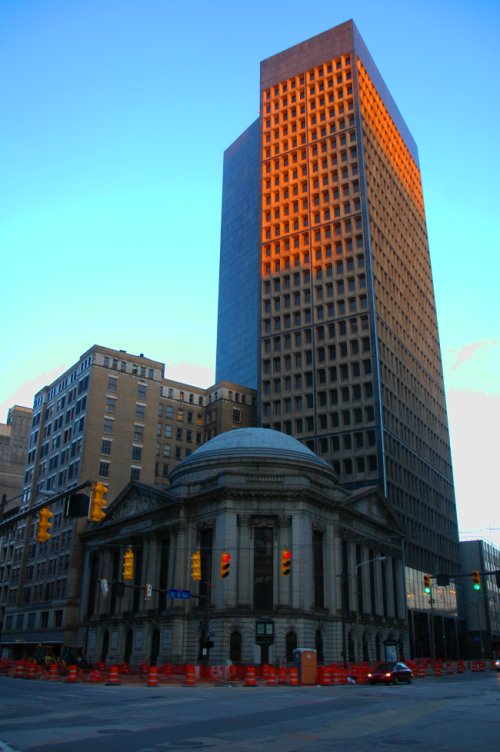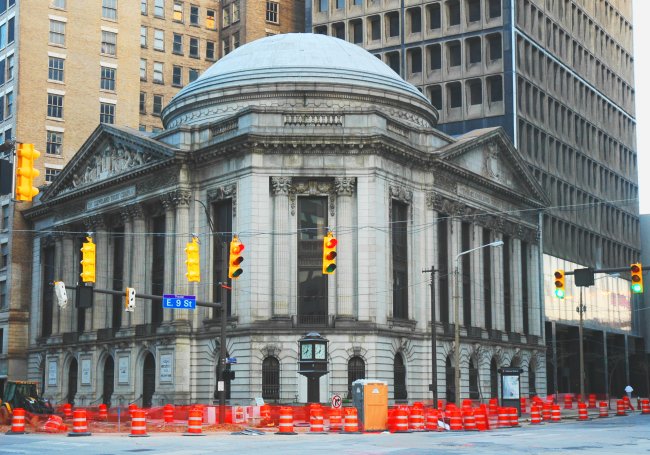Submitted by Norm Roulet on Mon, 04/30/2007 - 22:40.

I went down to photograph the Breuer and the Rotunda Sunday evening, as I have this feeling the Breuer is the best building down there - better than the Rotunda.
While Post was a good American architect, this is actually a relatively minor example of his buildings. It is quite old and inefficient - maintenance and renovation costs will be high - it doesn't seem well suited to the intended use.At 100 years old, the Post is well depreciated, although most raw materials and artistic elements of the building can be reused.

The Breuer, built in 1971, is in the early phase of its lifecycle - little of the Breuer can be reused... perhaps some granite It is arguable Breuer is the more important of the two architects and the Breuer tower is more important, as a representation of great architecture, an era and genre of work. The Breuer is a major Breuer, despite how it is presented by many in the community.
So, for many reasons, if they want to clear a building, the one to demolish is the Post Cleveland Trust Rotunda. They could keep both, but there is no justification for chosing the Post over the Breuer.
A good viewpoint on all this is found at a site featuring the 2007 List of Ohio's Most Endangered Historic Sites which includes the Breuer... read on:
Cleveland Trust Tower
Cleveland,
Cuyahoga County
The Cleveland Trust Tower was constructed in 1971 to the design of noted architect Marcel Breuer. Breuer, who was widely known for furniture design, was also the architect of the Whitney Museum of Art in New York City. Built in what is most commonly referred to as the Brutalis” style of architecture, the facade of the structure is composed primarily of black granite and concrete window forms which create a distinctive presence on the downtown skyline. The southern facade features a "cut out" on the tower's cornice.
The tower is adjacent to the historic Cleveland Trust Rotunda, a landmark designed by George B. Post. When the tower and Rotunda were no longer used, the buildings sat vacant for almost a decade. The buildings were purchased in September 2005 for $21,700,000 by the Cuyahoga County commissioners as the proposed location of the new county administrative center. The current architect’s plans call for demolition of the Tower, on the grounds that the tower's floorplans are inadequate and also on the basic assertion that a newer structure would "look better." Opponents of demolition suggest that the tower is an important landmark by a well-regarded architect, and that preservation would result in substantial savings of taxpayer funds. One consultant has pegged that savings as approaching $20 million.
In reality, the structure of the Cleveland Trust Tower is good and is adaptable to a wide variety of uses, due to its open floor plan and relatively wide column spacing. The building does contain asbestos, however that would have to be abated with both demolition and renovation.
It is quite likely that the death-knell for the Cleveland Trust Tower will be the lack of ornamentation commonly associated with so-called “historic” buildings. As a 32-year old building, it also has yet to reach the magic age when anything old becomes venerated. The Tower’s inclusion on the Most Endangered List is largely testament not only to the building, but to the lack of attention paid to our recent past. Without careful attention today, the landmarks of tomorrow will be lost.
NOTE: The Cuyahoga County Commissioners voted to proceed with demolition on March 29.
See this story.
Links for More Information:
Let the tower fall - Cleveland Plain Dealer
Marcel Breuer biography on Wikipedia
Cleveland Trust Rotunda page on clevelandskyscapers.com
Disrupt IT
$44 mill to be enslaved to fashion
This boondoggle of wasting $44 mill to tear down a building that some say is ugly is so oddly funny to me. Well not funny when you think of the logic missing in the equation that tries to add up to a green building. OK, but I am reminded of the trends in fashion. Pants that fit one's actual waist (somewhere above the iliac crest) were eschewed in the 1960s and early 70s. By the 80s hip huggers were out and women went hog wild for pleated high-waist pants. Hemlines were the measure for years of the fashion trend. The polyester shirt that John Travolta wore was eschewed in lieu of cotton in the 90s and styles went back to the button down and the synthetics were hidden from view (that cotton shirt wasn't entirely cotton, but made to look like it even though it didn't require the iron.
There was a strong subculture that brought back "vintage clothing" in the 80s and it continues today. Thank goodness as it allows us to appreciate styles from every era. I remember feeling oddly ill at ease back in my parent's home built in 1967 with its Formica countertops in the kitchen and doors so hollow you could easily put your foot through them; this after living for a while in a Cleveland Heights apartment with solid doors and wood countertops. Bathtubs in our family home were a joke compared to the tub I had become accustomed to bathing in in Cleveland Heights.
Then I noticed a store on Larchmere that offered "modern furniture", the big overstuffed 1940s horsehair covered armchairs, yes, but also designs that seemed dated to me, items from my childhood that I can remember my mother longing to toss out so she could have something new.
Now as I see teenage girls wearing the same style hip-hugger pants I used to sport at their age, I feel old enough to have watched the fashion wheel turn. People say that this architecture is ugly and outdated, hold your horses. When young architects begin to return to this sort of building style in a few years we may be very sorry to have lost a beautiful example of the style in our midst. More importantly, when we have the current economic woes that exist in our region with which to contend, where oh where to we come up with solutions that cost $44 million and call themselves green and efficient?
If the county commissioners want to build green they will choose a Brownfield (there are plenty of them and they are even mapped already!), or build atop an existing structure.
So as not to simply suggest and not offer an example... I recommend the commissioners and their architects consider this LEED Gold Standard building that combine green efficiencies and involved saving the historic street level building: The Hearst Tower in NYC.
These guys did it right. Not only did they save the 7 story original structure and maintain it's street level appearance, but they demolished it's insides appropriately and efficiently.
"The environmentally conscious approach began prior to construction. When demolishing the interior portions of the existing, six-story structure, Hearst and its team of building professionals went to great lengths to collect and separate recyclable materials. As a result, about 85 percent of the original structure was recycled for future use."
Learn more about this innovative project here at the Hearst website. http://www.hearst.com/tower/
Revive the Breuer discussion
What nefarious plans are underway for the symbolic Breuer Building as our NEO focus must constantly shift between corruption, local powerbrokering, the Port's plans and the underworld of NPI/SII/CDC plots?
Northeast Ohio is fortunate to have major institutional and university archives, the archive collections of the Rock Hall, internationally significant library collections, and notable institutions like the Cleveland Museum of Art and other University Circle institutions. The great unknown for many of these organizations is how to store, preserve and make these archival collections accessible to the public. Digitization of materials under a collective is also a challenge that has begun through the collaboration of Cleveland State University and Cleveland Public Library, but funding this effort and other preservation efforts is fragmented and the collections, as we watched recently with the dismantling of the Crawford Auto collection, are in jeopardy. The significant collections held by non-profit archive organizations--the Sculpture Center, Artist Archives of the Western Reserve, and Cleveland Artists Foundation, also face an uncertain future.
Please let me say this again--the central location and international appeal of the Breuer and the Post Rotunda offer the perfect location to centralize and to display these collections and to consolidate funding efforts for the preservation, digitization and worldwide access to these collections.
Let's not squander a real opportunity.
http://realneo.us/events/what-would-you-do-with-the-breuer-building-a-reprise-at-cia-nov-2007#comment-4588
spot on Laura
Great suggestion Laura. How would you move this forward?
Talk it up
I talk it up as much as I can--but a large player needs to get on board to convince the Cuyahoga County Commissioners that this would be an international public relations boost for Cleveland, Cuyahoga County and Northeast Ohio.
...And, notably, it would help to redeem the tarnished image of Cuyahoga County administration.